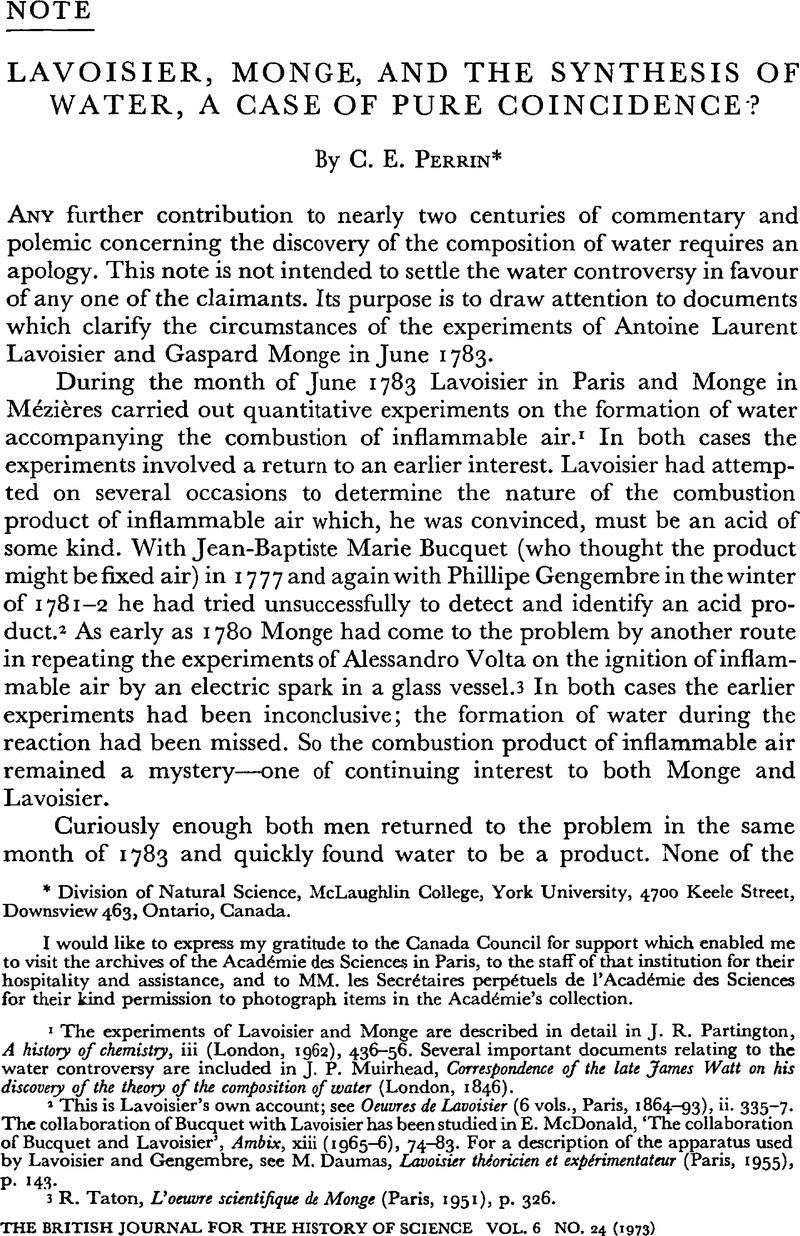Published online by Cambridge University Press: 05 January 2009

I would like to express my gratitude to the Canada Council for support which enabled me to visit the archives of the Académie des Sciences in Paris, to the staff of that institution for their hospitality and assistance, and to MM. les Secrétaires perpetuels de l'Academie des Sciences for their kind permission to photograph items in the Académie's collection.
1 The experiments of Lavoisier and Monge are described in detail in Partington, J. R., A history of chemistry, iii (London, 1962), 436–56.CrossRefGoogle Scholar Several important documents relating to the water controversy are included in Muirhead, J. P., Correspondence of the late James Watt on his discovery of the theory of the composition of water (London, 1846).Google Scholar
2 This is Lavoisier's own account; see Oeuvres de Lavoisier (6 vols., Paris, 1864–1893), ii. 335–7.Google Scholar The collaboration of Bucquet with Lavoisier has been studied in McDonald, E., ‘The collaboration of Bucquet and Lavoisier’, Ambix, xiii (1965–1966), 74–83.Google Scholar For a description of the apparatus used by Lavoisier and Gengembre, see Daumas, M., Lavoisier théoricien et expérimentateur (Paris, 1955), p. 143.Google Scholar
3 Taton, R., L'oeuvre scientifique de Monge (Paris, 1951), p. 326.Google Scholar
4 Ibid., p. 328.
5 Crell's Chemische Annalen, i, part 1 (1786), 58–61.Google Scholar An English version is given by Muirhead, , op. cit. (1), pp. 71–4Google Scholar, and is reproduced (partly abridged) in Partington, , op. cit. (1), iii. 441.Google Scholar
6 The chronology of Priestley's discoveries can be traced readily in the exchange of letters between Priestley and Watt during this period; see Muirhead, op. cit. (1). This curious episode is also the subject of a recent article by Smeaton, W. A., ‘Is water converted into air? Guyton de Morveau acts as arbiter between Priestley and Kirwan’, Ambix, xv (1968), 73–83.CrossRefGoogle Scholar
7 Philosophical transactions of the Royal Society, lxxiii (1783), 398–434.Google Scholar
8 ‘Procès-verbaux’, 7 05 1783.Google Scholar These extracts from the official, manuscript minutes of the Académie are taken from the folio volumes housed in the archives of the Académie des Sciences.
9 ‘Procès-verbaux’, 14 05 1783.Google Scholar The letter itself is filed under the same date in the ‘Dossiers des séances’, a chronological series of envelopes in the archives of the Académie des Sciences which contains materials relating to each meeting of the Académie.
10 Observations sur la physique, xxii (1783), 465–8.Google Scholar
11 This is the text of the second of two experiments described in the note pinned to Genet's letter of 6 May (note 9)—the other describing a conversion of water to air. It appears that these descriptions (in what looks like a secretarial hand) were written before Priestley had discovered his error in the latter experiment. Added on in a different hand is an excerpt from the (attached) Genet letter of 6 May announcing Priestley's correction of his earlier error. In the upper lefthand corner of both documents the notation ‘14 mai 1783’ is added, probably by Condorcet. I believe that this composite note was prepared for reading to the Académie on 14 May, juxtaposing earlier reports of Priestley's experiments (probably those read on 7 May) with his revised interpretation.
12 ‘Procès-verbaux’, 31 05 1783.Google Scholar
13 In the case of Lavoisier the earlier apparatus was supplemented by a second caisse pneumatique (allowing steady flow of both gases) and a double-nozzle jet for the combustion. The date of construction of this apparatus is uncertain but probably falls in the early part of 1783; see Daumas, , op. cit. (2), p. 143.Google Scholar